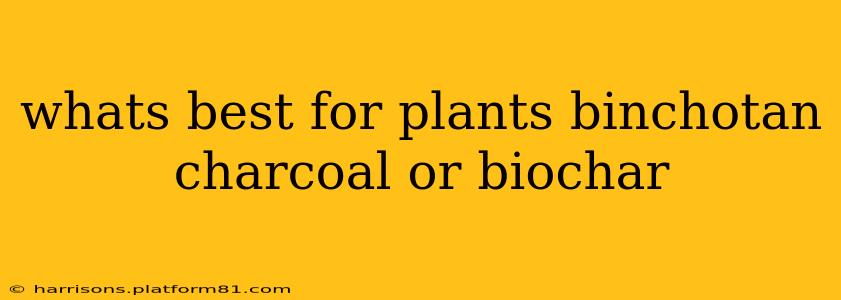Binchotan Charcoal vs. Biochar for Plants: Which is Best?
Choosing between binchotan charcoal and biochar for your plants can feel overwhelming. Both are forms of charcoal, offering potential benefits to soil health and plant growth, but they differ significantly in their origins, properties, and effects. This comprehensive guide will clarify the distinctions and help you determine which is the superior choice for your gardening needs.
What is Binchotan Charcoal?
Binchotan charcoal, originating from Japan, is a premium type of charcoal made from the Quercus phillyreoides tree (also known as ubame oak). It's known for its incredibly high density and porosity, created through a unique, traditional firing process. This process results in a charcoal with exceptional water absorption and retention capabilities, making it a popular choice for water filtration and culinary uses.
What is Biochar?
Biochar is a charcoal produced from the pyrolysis of various biomass materials—anything from wood waste and agricultural residues to animal manure. The pyrolysis process, which involves heating the material in the absence of oxygen, creates a stable form of carbon that can significantly improve soil health. The specific properties of biochar vary widely depending on the source material and the pyrolysis process used.
What are the Benefits of Binchotan Charcoal for Plants?
- Improved Water Retention: Binchotan's high porosity allows it to absorb and release water gradually, providing consistent moisture to plant roots. This is particularly beneficial in drier climates or for plants susceptible to drought stress.
- Enhanced Drainage: While retaining water, binchotan also improves soil drainage by preventing waterlogging, crucial for root health.
- Nutrient Release: It can slowly release minerals and nutrients into the soil, acting as a natural fertilizer. However, this nutrient contribution is generally less significant than other fertilizer options.
- pH Regulation: Binchotan can subtly influence soil pH, potentially creating a more favorable environment for certain plants.
What are the Benefits of Biochar for Plants?
- Increased Soil Fertility: Biochar significantly improves soil structure and aeration, leading to better nutrient availability for plant uptake. It provides a larger surface area for beneficial microbes to thrive.
- Improved Water Retention and Drainage: Similar to binchotan, biochar can improve both water retention and drainage, depending on its characteristics. However, the effect is often less dramatic than with binchotan.
- Carbon Sequestration: Biochar's stable carbon structure helps lock carbon in the soil, mitigating climate change effects.
- Enhanced Microbial Activity: Biochar provides a habitat for beneficial soil microorganisms, enhancing overall soil health and nutrient cycling.
Which is better for plants? Binchotan or Biochar?
The "better" choice depends entirely on your specific needs and priorities.
-
For improved water retention and drainage in specific situations (e.g., small potted plants, drought-prone areas): Binchotan charcoal might be preferable due to its superior water-holding capacity and drainage properties. Its finer particle size and density also make it more readily suitable for mixing into potting mixes.
-
For long-term soil improvement and carbon sequestration: Biochar provides a more holistic soil amendment, improving soil structure, fertility, and microbial activity over the long term. It's a more sustainable option since it is made from waste products and its creation can aid carbon sequestration. The larger particle size often makes it more suitable for incorporation into garden beds rather than small pots.
-
Cost: Biochar is generally more affordable than binchotan, making it a more economically viable option for large-scale applications.
How to Use Binchotan and Biochar for Plants?
Both binchotan and biochar can be incorporated into your potting mix or garden soil. For binchotan, smaller pieces work well for potting mixes, while larger pieces can be used in the bottom of pots to improve drainage. For biochar, it’s often incorporated directly into the garden soil or mixed into potting mixes at a rate depending on the type and the soil needs. It's crucial to research the appropriate application rate for each.
What are the potential drawbacks of using biochar?
While biochar offers many benefits, some potential drawbacks include:
- Variability in quality: The quality of biochar can vary significantly depending on the feedstock and pyrolysis method. Ensure you're sourcing biochar from a reputable supplier.
- Potential for nutrient depletion (in some cases): Depending on the feedstock and process, some biochars may initially tie up nutrients, requiring supplemental fertilization.
- Nutrient availability: Biochar doesn't provide a direct source of essential plant nutrients. It improves soil conditions, facilitating the access of nutrients that are already present.
Ultimately, both binchotan charcoal and biochar can be valuable additions to your gardening practices. Consider your specific needs, budget, and long-term goals to make an informed decision. A soil test can be very helpful in determining the best course of action for your specific soil conditions.
